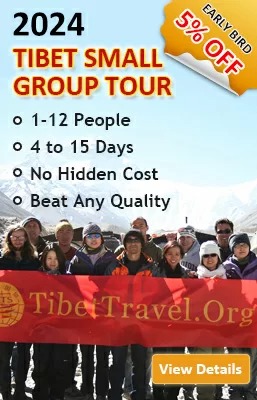
Lake Tangra Yumco
Location
Start towards southwest from Nyima country, after 8 kilometers turn left at the crossroad. Go straight in the south direction about 80 kilometers, and cross a mountain pass at about elevation 5 kilometers, and you’ll arrive at Tangra Yumco lake basin.
Introduction
Lake Tangra Yumco is considered as a holy lake in Bon Religion followers. Lake Tangra Yumco lies in the deep lake basin bottom, next to Tangra Qonco. Actually, they are in the same lake basin. It is said that they were the same lake long time ago. That is how the name, Tangra Qonco comes. In Tibetan, Tangra Qonco means little Tangra Yumco. It is said that water of the lake may change into three different colors a day. In the west bank, there stand continuous dark red cliffs, just like a row of screen. These cliffs clearly recorded every water decline in Lake Tangra Yumco. Stone steps eroded by the lake water surround the lake round in round from the top mountain at the lakeshore to the lakefront. Go ahead from Lake Tangra Qonco, after about 5 kilometers, and you’ll see the most famous holy lake in the north Tibet: Lake Tangra Yumco.
Tangra Yunco runs from south to north, shaping like a big shoe. The lake is surrounded on three sides by mountain, with only a gap at Dargo Mountain in the south lakeshore. There are seven peaks in Dargo Mountain, just like seven neatly ranked pyramids. The mountain together with the Lake Tangra Yumco is respected as the holy place by Bon Religion followers. Beside the lake there is a monastery, Yubon Monastery, built in the scarp cave. It is said that Yubon Monastery is the oldest one in Bon Religion.
At the shore of Lake Tangra Yumco, there is a small village with nearly 100 households, Wenbu. Majority of the villagers live partly on agriculture, partly on livestock. They explored a little field on the lakeshore and plant qingke, tomatoes, cole and green Chinese cabbages etc. It’s amazing to see these plants being planted in the place above elevation 4,500 meters, thanks to the Lake District climate.
Wenbu villagers show no fear of either earthquakes or active volcanic mountain. In the eyes of the villagers, Wenbu is the paradise most suitable for them to multiply.
Located in north Tibet, Wenbu is not cold in winter at all. When we are there, we do not need to wear the heavy coat necessary in other parts of north Tibet. In that part of the world, you may find qingke barley wine thriving. This is unusual in north Tibet, whose fierce climate makes growing the barley almost impossible. The per-hectare yield reaches 3,000 kg.
A legend among Wenbu Villagers
Long, long ago, people living here did not grow qingke barley. To eke out a living, they drove sheep fully loaded with salt to the remote farming areas to exchange for barley. Given the long distance involved, they still could not get enough to eat.
One couple-Dargo Mountain and Tangra Yumco Lake-were uneasy about seeing this tragedy. The husband-Holy Mountain of Dargo went on an expedition and seized a bag of qingke barley from Quxui. As he fought his way back, an arrow hit his bag of barley. The qingke barley spilled out from the hole made by the arrow. When he met his wife-Tangra Yumco Lake, only a handful of barley were left, so he scattered this by the lake, and his wife watered the field with her milk. This produced the thriving fields of barley in the village.
As a token of gratitude for the couple, Wenbu people have since ancient times been worshiping the holy mountain and holy lake by offering sacrifices to them before spring plowing and autumn harvesting. Sacrifices offered include wine brewed with local barley.
Bon Religion
At the entrance of Wenbu Village you can find a Sutra Wheel Spinning House furnished with a giant sutra tube for worshippers to spin. Unlike those in other parts of Tibet, they turn the tube leftward in silence. Worshippers of the Bon religion spin sutra wheels or tubes leftward. In Tibetan, Bon means substance, implying that the Bon religion is a religion for all in the universe. It is hence the oldest religion in the world.
Songs relating to the leftward spinning of sutra wheels or tubes unique to the Bon religion coincides with the movement of the earth around the sun. Such logic is found also in rock paintings found in Ritog. Thus, it would seem to have much to do with the movement of the solar system, but no one can find clearly explain it today.
Legend has it that the Bon religion, founded by Tunba Sinrao, has 108 volumes of Gangyur and 280 volumes of Dangyur. Gangyur that include the teachings of the Bon religious founder on the origin of the universe, biographies of worshippers, prayer words and rules. Dangyur includes religious rituals, explanations to teachings by Bon religious founders, and contents related to logics, medicine and industrial arts.
The Bon religion has been passed down through history orally or by hiding a considerable amount of sutras in mountain caves or rock cracks in central, southern and northern Tibet.
It is said that when an eminent monk of the Bon religion practiced divination in a mountain close to Wenbu, he saw a vision of the founder who orally passed him the Dangla Garcha, a Bon sutra, Dangla Garcha refers to A Laud to Dangla, which depicts a goddess riding a white lion and donned in the best dresses in the world. Accompanied by many heavenly maids she descended from the heaven to Tangra Yumco Lake. As she reached the lake, the vast skies were irradiated with colorful rays. And when the goddess reached the bottom of the lake, a fantastic city appeared.
To bless the world, the goddess invited heavenly treasures to be buried in various parts of Tibet.
The eminent monk recorded all he was told and his records turned out to be a much favored sutra book of the Bon religion.






35 Comment ON "Lake Tangra Yumco"
Asked by Liliana Me** from Macau
plan a 7-8days trip for me and my boyfriend in April
Hi! I would like to plan a 7-8days trip for me and my boyfriend in April (3rd to 10th ideally) to Nepal, Tibet, and, if possible, Bhutan. Do you think it would be doable? Based on what I read, there are some places/things to do to consider: Nepal: Everest Base Camp trek and the Annapurna Circuit, ancient temples, sacred sites like Lumbini, Kathmandu, Tibet: The Potala Palace in Lhasa and the Jokhang Temple. eventually the holy Mount Kailash or the high-altitude plains. Bhutan: Thimphu, Paro, and the famous Tiger’s Nest Monastery. To take part in cultural traditions, yoga, meditation... Of course I am open to any recommendations you could make. For your reference, we are both based in Asia: him, in Bangkok and myself in Macau. Thank you so much for the information you could provide and, if possible, an estimated budget for your offer.
Asked by Ke** from Singapore
Cycling Tour to Mt Kailash
Hi , we are planning a Cycling Trip once Tibet opens for Tourism. The plan is we shall arrive to Kathmandu , travel to the border and enter via Kerung. Can you pls send a day to day Itinerary starting from Kerung - Lake Manasarovar - Darchen - Asthapath. We shall go around Kailash on foot and resume Cycling back to Kerung. We are a Group of 6-8 persons. Thanks Pls send ur reply to Kevin
Asked by Debo** from USA
Please can you tell me the prices and dates for the Tibet Luxury Tour.
Also, could you please provide a detailed itinerary - I want to see how many hours are spent on buses/vehicles. Thank you! Deborah
Asked by S** from HongKong
Tibet Tour from HK
May I know if holding Mainland Travel Permit for HK Residents. is it also need to get the visa permit to Tibet and what is the procedure if need to apply? Thank you
Asked by Na** from USA
Is Kailash Mansarovar Trip open for Indian Passport Holder?
Is it open for Indian Passport Holder?
Asked by A** from Singapore
Enquiry on private tour
We are planning a trip from Hong Kong to Tibet during the 12th to 21st of April. We want a private tour that covers all the scenic places as well as the EBC. Please advise an itinerary along with the cost breakdown. Thanks.
Asked by Na** from Canada
We would like to take the train from Xining to Lhasa
Asked by Gr** from Canada
The "Tibet Entry Permit" should be apply
Asked by Tam** from Singapore
Sightseeing Potala Palace
Asked by Ka** from Singapore
plan to travel to Mount Kailash